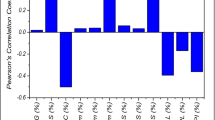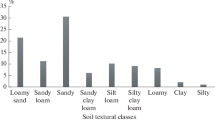Abstract
Sensitivity and error analyses and machine-based prediction have been conducted on the erodibility response of erodible unsaturated soil (degree of saturation 60%) treated with local cement and modified with nanostructured quarry fines. The machine-based exercise has become necessary because of the incessant washing away of soil on erosion watersheds causing devastating gullies around the developing world and the need to propose model equations to study, design and proffer future solutions to this environmental problem. Also, in order to overcome complex experimental setup needed to repeatedly study erosion problems, there is also need to forecast model equations by employing variables that can easily be determined as predictors of the model. This work was aimed at the prediction of erodibility and generating a model equation using the ANN learning technique. The erodible soil was collected and classified as poorly graded, highly plastic and as an A–7–6 group. 121 datasets were generated from multiple experiments for the input parameters and deployed in model training and testing in the ratio of 70 to 30%, respectively. The model performance was validated and error analysis was conducted using R2, MAE, MSE, RMSE and MAPE indices. The performance showed that the model has R2 of more than 0.95 in both training and testing between the predicted and measured values. Also, the error indices showed significantly small values, which showed good performance. Finally, the sensitivity analysis outcome showed that the liquid limit was the most influential on the erodibility model results. Generally, ANN technique has shown to be very flexible in forecasting civil engineering problems and fundamentally in proposing model equations.









Similar content being viewed by others
Data availability
The data supporting the results of this research work have been presented in the manuscript.
Abbreviations
- Er (K):
-
Erodibility
- [Er]max :
-
Maximum values of predicted erodibility
- [Er]min :
-
Minimum values of predicted erodibility
- ANN:
-
Artificial neural network
- GP:
-
Genetic programming
- GEP:
-
Gene expression programming
- EPR:
-
Evolutionary polynomial regression
- ANFIS:
-
Adaptive neuro-fuzzy inference system
- NQF:
-
Nanostructured quarry fines
- ANNS:
-
Agile neural network software
- SA:
-
Sensitivity analysis
- EA:
-
Error analysis
- r:
-
Correlation coefficient
- R2:
-
Coefficient of determination
- MSE:
-
Mean square error
- MAE:
-
Mean absolute error
- RMSE:
-
Root mean square error
- MAPE:
-
Mean absolute percentage error
- MATLAB:
-
Matrix laboratory
- MFNN:
-
Multilayer feed-forward neural network
- CDW:
-
Construction and demolition waste
- HC:
-
Hybrid cement
- CL:
-
Clay content
- Ac :
-
Clay activity
- Cc :
-
Coefficient of curvature
- Cu :
-
Coefficient of uniformity
- \(\delta\) max :
-
Maximum dry density
- Wmax :
-
Optimum moisture content
- \(\delta\) part :
-
Partial maximum dry density
- WL :
-
Liquid limit
- Ip :
-
Plasticity index
- Nc :
-
Cohesion
- \(\varnothing ^\circ\) :
-
Frictional angle
- \(\gamma\) unsat :
-
Unsaturated unit weight
- Doc :
-
Degree of compaction
References
Onyelowe KC, Van Bui D, Ikpemo OC, Ubachukwu OA, Van Nguyen M (2018) Assessment of rainstorm induced sediment deposition, gully development at Ikot Ekpene, Nigeria and the devastating effect on the environment. Environ Technol Innov 10:194–207. https://doi.org/10.1016/j.eti.2018.02.008
Onyelowe KC (2017) The menace of the Geo-Environmental hazard caused by gully erosion in Abia State, Nigeria. Environmental Technology & Innovation 8; 343–348.www.elsevier.com/locate/eti. https://doi.org/10.1016/j.eti.2017.08.006.
NEWMAP (2017). Abia State Nigeria Erosion and Watershed Management Project, Volume 11, GIS Mapping of Abia State Erosion Watershed. ABS/NEWMAP/QCBS/CON/16/01.
Behera RN, Patra CR (2018) Ultimate bearing capacity prediction of eccentrically inclined loaded strip footings. Geotech Geol Eng 36(2018):3029–3080
Dutta RK, Dutta K, Jeevanandham S (2015) Prediction of deviator stress of sand reinforced with waste plastic strips using neural network. Int J Geosynth Ground Eng 1(2):1–12
Gnananandarao T, Khatri VN, Dutta RK (2020) Prediction of bearing capacity of H shaped skirted footings on sand using soft computing techniques. Archive Mater Sci Eng 103(2):62–74
Dutta RK, Gnananandarao T, Ladol S (2020) Soft computing based prediction of friction angle of clay. Archive Mater Sci Eng 104(2):58–68. https://doi.org/10.5604/01.3001.0014.4895
Onyelowe KC, Iqbal M, Jalal F, Onyia M, Onuoha I (2021) Application of 3 algorithm ANN programming to predict the strength performance of hydrated-lime activated rice husk ash treated soil. Multiscale Multidiscip Model Exp Des. https://doi.org/10.1007/s41939-021-00093-7
Onwuka DO, Awodiji TGC (2013) Artificial neural network for the modulus of rupture of concrete. Adv Appl Sci Res 4(4):214–223
Khan SU, Ayub T, Rafeeqi SFA (2013) Prediction of compressive strength of plain concrete confined with ferro-cement using artificial neural network (ANN) and comparison with existing mathematical models. Am J Civil Eng Archit 1(1):7–14. https://doi.org/10.12691/ajcea-1-1-2
Das S, Pal P, Singh RM (2015) Prediction of concrete mix proportion using ANN technique. Int Res J Eng Technol 2(5):820–825
Panagiotis GA, Ioannis A, Liborio C, Hugo R, Humberto V, Job T, Paulo BL (2019) Masonry compressive strength prediction using artificial neural networks. TMM_CH. https://doi.org/10.1007/978-3-030-12960-6_14
Rama MP, Rao HS (2012) Prediction of compressive strength of concrete with different aggregate binder ratio using ANN model. Int J Eng Res Technol 1(10):1–10
Ogbodo MC, Dumde DK (2017) Prediction of concrete strength using artificial neural network. Int J Adv Res Publ 1(6):74–77
Chandan MK, Raghu PB, Amarnath K (2017) Design of reinforced concrete structures using neural networks. Int Res J Eng Technol (IRJET) 4(7):2012–2018
Noorzaei J, Hakim SJS, Jaafar MS, Thanoon WAM (2007) Development of artificial neural network for prediction of compressive strength of concrete. Int J Eng Technol 4(2):141–153
Dantas ATA, Leite MB, Nagahama KJ (2013) Prediction of compressive strength of concrete containing construction and demolition waste using artificial neural networks. Constr Build Mater 38:717–722
Krishna AS, Rao VR (2019) Strength prediction of geopolymer concrete using ANN. Int J Recent Technol Eng (IJRTE) 7:661–667
Iyeke SD, Eze EO, Ehiorobo JO, Osuji SO (2016) Estimation of shear strength parameters of lateritic soils using artificial neural network. Niger J Technol (NIJOTECH) 35(2):260–269. https://doi.org/10.4314/njt.v35i2.5
Sharmila S, Lekha G, Kaushik S (2016) Cost and time effective prediction of soil characteristics using ANN model. Int J Innov Res Sci Eng Technol 5(3):3829–3834. https://doi.org/10.15680/IJIRSET.2016.0503087
Sharad KJ, Singh VP, Genuchten M (2004) Analysis of soil water retention data using artificial neural networks. J Hydrol Eng 9(5):415–420. https://doi.org/10.1061/~ASCE1084-0699~20049:5~415
Sarmadian S, Mehrjardi RJ (2010) Development of pedotransfer functions to predict soil hydraulic properties in golestan province, Iran. 19th World Congress of Soil Science Soil Solutions for a Changing World, 59–62.
Kumar VP, Rani SC (2004) Prediction of compression index of soils using artificial neural networks (ANNs). Int J Eng Res Appl (IJERA) 1(4):1554–1558
Kuo YL, Jaksa MB, Lyamin AV, Kaggwa WS (2009) ANN-based model for predicting the bearing capacity of strip footing on multi-layered cohesive soil. Comput Geotech 36:503–516
Kurnaz TF, Dagdeviren U, Yildiz M, Ozkan O (2016) Prediction of compressibility parameters of the soils using artificial neural network. Springer Plus 5:1–11. https://doi.org/10.1186/s40064-016-3494-5
Onyelowe KC, Van Bui D, Ubachukwu O, Ezugwu C, Salahudeen B, Van Nguyen M, Ikeagwuani C, Amhadi T, Sosa F, Wu W, Duc Thinh Ta, Eberemu A, Duc Tho Pham, Barah O, Ikpa C, Orji F, Alaneme G, Amanamba E, Ugwuanyi H, Sai Vishnu, Kadurumba C, Selvakumar S, Ugorji B (2019) Recycling and reuse of solid wastes; a hub for eco-friendly, ecoefficient and sustainable soil, concrete, wastewater and pavement reengineering. Int J Low-Carbon Technol 14(3):440–451. https://doi.org/10.1093/Ijlct/Ctz028
American Standard for Testing and Materials (ASTM) C618 (1978) Specification for Pozzolanas. ASTM International, Philadelphia, USA
BS 1377–2, 3 (1990) Methods of Testing Soils for Civil Engineering Purposes. British Standard Institute, London
A Standard for Testing and Materials (ASTM) E1621–13 (2013) Standard guide for elemental analysis by wavelength dispersion x-ray fluorescence spectrometry. ASTM International, West Conshohocken, PA. https://doi.org/10.1520/E1621-13
BS 1924 (1990) Methods of Tests for Stabilized Soil. British Standard Institute, London
Garson GD (1991) Interpreting neural-network connection weights. AI Expert 6(4):46–51
Olden JD, Jackson DA (2002) Illuminating the “black box”: a randomization approach for understanding variable contributions in artificial neural networks. Ecol Model 154:135–150
Gnananandarao T, Dutta RK, Khatri VN (2019) Application of artificial neural network to predict the settlement of shallow foundations on cohesionless soils. Geotech Appl Lect Notes Civil Eng 13(2019):51–58. https://doi.org/10.1007/978-981-13-0368-5_6
Author information
Authors and Affiliations
Corresponding author
Ethics declarations
Conflict of interests
The authors have no conflicting interests to report in this work.
Additional information
Publisher's Note
Springer Nature remains neutral with regard to jurisdictional claims in published maps and institutional affiliations.
Supplementary Information
Below is the link to the electronic supplementary material.
Rights and permissions
About this article
Cite this article
Onyelowe, K.C., Gnananandarao, T. & Nwa-David, C. Sensitivity analysis and prediction of erodibility of treated unsaturated soil modified with nanostructured fines of quarry dust using novel artificial neural network. Nanotechnol. Environ. Eng. 6, 37 (2021). https://doi.org/10.1007/s41204-021-00131-2
Received:
Accepted:
Published:
DOI: https://doi.org/10.1007/s41204-021-00131-2




